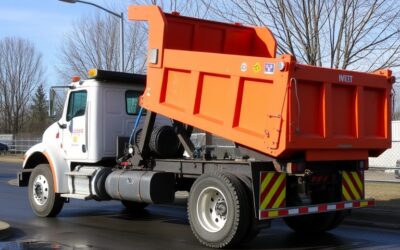Dump trucks face serious tipping risks, especially when hauling heavy or uneven loads. The WINK Anti-Tip system offers a proactive solution, keeping drivers safe and reducing costly incidents. Ensuring the safety of these vehicles is vital for preventing accidents that can lead to injuries and substantial financial losses. This is where the WINK Anti-Tip system comes into play, providing a cutting-edge solution to these persistent safety challenges.
The WINK Anti-Tip system is designed to monitor and react to changes in a dump truck’s balance. By detecting imbalances early and making automatic adjustments, the system helps to maintain stability and prevent tip-overs. This not only protects the driver but also extends the lifespan of the vehicle by reducing wear and tear from tipping incidents.
Understanding how the WINK Anti-Tip system works can provide valuable insights for truck operators looking to enhance safety measures. From its core components to its automatic adjustment mechanisms, the technology is aimed at creating a safer, more efficient working environment. In this article, we will explore the key aspects of this advanced safety system and how it contributes to improving the overall stability of dump trucks.
Core Components of the WINK Anti-Tip System
The WINK Anti-Tip system combines smart sensors, a control unit, and automatic adjustment mechanisms to keep dump trucks stable and secure. One of the main components is the advanced sensor array. These sensors are strategically placed on the truck to monitor the vehicle’s tilt, load distribution, and overall balance. The sensors are highly sensitive and provide real-time data, allowing the system to detect even the slightest shifts in the truck’s stability.
Another essential component is the control unit, which acts as the brain of the WINK Anti-Tip system. The control unit receives data from the sensors and analyzes it to determine if corrective action is needed. This unit is equipped with sophisticated algorithms that can instantly assess the risk of a tip-over and decide on the best course of action. It then sends commands to the adjustment mechanisms to maintain the truck’s stability.
How WINK Anti-Tip Detects Imbalances
WINK Anti-Tip’s sensors continuously monitor truck balance and detect any potential tilts or imbalances, instantly alerting the control unit to respond. The system’s sensors continuously monitor various parameters, such as the truck’s angle, speed, and load distribution. When these sensors detect that one side of the truck is higher or lower than the other, they send this information to the control unit.
The control unit processes this data and quickly identifies any potential hazards. For example, if the data shows that the truck is tilting beyond a safe angle, the control unit recognizes this as a potential tip-over risk. It then takes immediate action to prevent an accident, such as alerting the driver or lowering the truck bed to redistribute the load. By detecting imbalances early, the WINK Anti-Tip system plays a crucial role in maintaining the safety and stability of dump trucks.
Automatic Adjustment Mechanism Explained
The automatic adjustment mechanism in WINK Anti-Tip quickly corrects imbalances, making instant adjustments to keep the truck stable. When the control unit identifies a tilt or uneven load, it sends immediate commands to the adjustment mechanism. This could include lowering one side of the truck bed or adjusting the suspension to balance the load more evenly.
This process happens almost instantaneously, thanks to the advanced technology integrated into the WINK Anti-Tip system. The adjustment mechanism ensures that the truck returns to a stable position quickly, minimizing the risk of a tip-over. By automatically making these adjustments, the system reduces the need for the driver to take manual corrective actions, which can be slower and less effective. This automation is crucial for maintaining safety, especially in dynamic environments where conditions can change rapidly.
Enhancing Truck Safety with WINK Anti-Tip Features
From real-time driver alerts to historical data tracking, WINK Anti-Tip provides essential tools for dump truck safety. One of the key features is the real-time alert system. When an imbalance or potential tip-over is detected, the system immediately alerts the driver. This early warning allows the driver to take additional precautionary measures, such as reducing speed or adjusting their route.
Another important feature is the historical data tracking. The WINK Anti-Tip system keeps a record of past stability issues and adjustments. This data can be used for trend analysis and proactive maintenance. By understanding when and where imbalances most frequently occur, operators can plan better routes and schedules to avoid risky situations. These features collectively contribute to a safer working environment and more reliable truck operations.
Conclusion
Keeping dump trucks safe is crucial for every job site. With WINK Anti-Tip, drivers gain real-time alerts, automatic adjustments, and peace of mind, ensuring stability and safety in all conditions. The WINK Anti-Tip system provides a comprehensive solution by detecting imbalances, making automatic adjustments, and alerting drivers in real-time. These advanced features work together to maintain the stability of dump trucks, reducing the risk of tip-overs and enhancing overall safety.
Understanding how the WINK Anti-Tip system functions can help operators take full advantage of its capabilities. Whether it’s through automatic adjustments or data-driven insights, this technology is crucial for modern dump truck operations. Investing in such a system not only protects the driver and the vehicle but also improves operational efficiency by minimizing downtime and maintenance needs.
If you’re looking to enhance dump truck safety, explore the benefits of the WINK Anti-Tip system. Learn more about how our technology can make your operations safer and more efficient. Make the smart choice for your fleet today!





